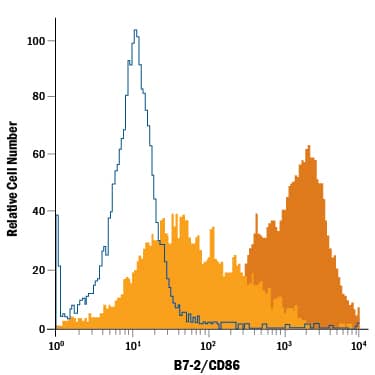Mouse B7-2/CD86 PE-conjugated Antibody
R&D Systems, part of Bio-Techne | Catalog # FAB741P


Key Product Details
Species Reactivity
Validated:
Cited:
Applications
Validated:
Cited:
Label
Antibody Source
Product Specifications
Immunogen
Specificity
Clonality
Host
Isotype
Scientific Data Images for Mouse B7-2/CD86 PE-conjugated Antibody
Detection of B7-2/CD86 in Mouse Splenocytes by Flow Cytometry.
Mouse splenocytes either untreated (light orange filled histogram) or treated with 1 µg/mL LPS for 3 days (dark orange filled histogram) were stained with Rat Anti-Mouse B7-2/CD86 PE-conjugated Monoclonal Antibody (Catalog # FAB741P) or isotype control antibody (Catalog # IC006P, open histogram). View our protocol for Staining Membrane-associated Proteins.Applications for Mouse B7-2/CD86 PE-conjugated Antibody
Flow Cytometry
Sample: Mouse splenocytes treated with LPS
Formulation, Preparation, and Storage
Purification
Formulation
Shipping
Stability & Storage
- 12 months from date of receipt, 2 to 8 °C as supplied.
Background: B7-2/CD86
B7-1 and B7-2, together with their receptors CD28 and CTLA-4, constitute one of the dominant costimulatory pathways that regulate T- and B-cell responses. Although both CTLA-4 and CD28 can bind to the same ligands, CTLA-4 binds to B7-1 and B7-2 with a 20-100 fold higher affinity than CD28 and is involved in the down‑regulation of the immune response. B7-1 is expressed on activated B cells, activated T cells, and macrophages. B7-2 is constitutively expressed on interdigitating dendritic cells, Langerhans cells, peripheral blood dendritic cells, memory B cells, and germinal center B cells. Additionally, B7-2 is expressed at low levels on monocytes and can be up-regulated through Interferon gamma. B7-1 and B7-2 are both members of the immunoglobulin superfamily. Mouse B7-2 is a 309 amino acid (aa) protein containing a putative 23 aa signal peptide, a 221 aa extracellular domain, a 21 aa transmembrane domain, and a 44 aa cytoplasmic domain. Mouse B7-2 and B7-1 share 28% amino acid identity. Mouse and human B7-2 share 50% amino acid identity. However, it has been observed that both human and mouse B7‑1 and B7-2 can bind to either human or mouse CD28 and CTLA-4, suggesting that there are conserved amino acids which form the B7-1/B7-2/CD28/CTLA-4 critical binding sites.
Alternate Names
Gene Symbol
Additional B7-2/CD86 Products
Product Documents for Mouse B7-2/CD86 PE-conjugated Antibody
Product Specific Notices for Mouse B7-2/CD86 PE-conjugated Antibody
For research use only